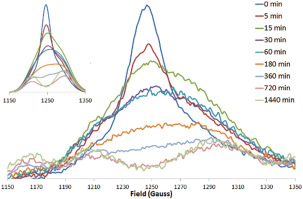当前位置:
X-MOL 学术
›
J. Inorg. Biochem.
›
论文详情
Our official English website, www.x-mol.net, welcomes your feedback! (Note: you will need to create a separate account there.)
Significance of conformation changes during the binding and release of chromium(III) from human serum transferrin.
Journal of Inorganic Biochemistry ( IF 3.9 ) Pub Date : 2020-02-15 , DOI: 10.1016/j.jinorgbio.2020.111040 Kyle C Edwards 1 , Hannah Kim 1 , Riley Ferguson 1 , Molly M Lockart 1 , John B Vincent 1
Journal of Inorganic Biochemistry ( IF 3.9 ) Pub Date : 2020-02-15 , DOI: 10.1016/j.jinorgbio.2020.111040 Kyle C Edwards 1 , Hannah Kim 1 , Riley Ferguson 1 , Molly M Lockart 1 , John B Vincent 1
Affiliation

|
Trivalent chromium has been proposed to be transported in vivo from the bloodstream to the tissues via endocytosis by transferrin (Tf), the major iron transport protein in the blood. While both Cr(III) binding and release from Tf have been proposed to be too slow to be physiologically relevant, recent kinetic studies under physiological conditions demonstrate that Cr(III) binding and release are sufficiently fast to occur during the time of the endocytosis cycle (circa 15 min). Consequently, the release of Cr(III) from human and bovine serum Tf has been examined under conditions mimicking an endosome during endocytosis. These studies have also found that Cr(III)2-Tf can exist in multiple conformations giving rise to different spectroscopic properties and different rates of Cr(III) release. Time-dependent spectroscopic studies of the binding and release of Cr(III) from human serum Tf have been used to identify three different conformations of Cr(III)2-Tf. The conformation of Cr(III)2-Tf used in most previous studies forms too slowly to be physiologically relevant and slowly releases Cr(III) in endosomal pH range. The conformation formed between 5 min to 60 min after the addition of Cr(III) to apoTf at pH 7.4 in 25 mM bicarbonate resembles the conformation of Cr(III)2-Tf in its complex with Tf receptor (TfR) and loses Cr(III) rapidly at endosomal pH, although not as fast as the Tf-TfR complex. The significance of these conformations and the potential role of Tf in detoxification of Cr(III) are described.
中文翻译:

人血清转铁蛋白结合和释放铬(III)过程中构象变化的意义。
已提出三价铬在体内通过转铁蛋白(Tf)(血液中主要的铁转运蛋白)的内吞作用从血流转运至组织。虽然 Cr(III) 结合和 Tf 释放都被认为太慢而无法产生生理相关性,但最近在生理条件下的动力学研究表明,Cr(III) 结合和释放足够快,可以在内吞循环期间发生(约 15 分钟)。因此,在模拟内吞作用过程中内体的条件下,对人和牛血清 Tf 中 Cr(III) 的释放进行了检查。这些研究还发现 Cr(III)2-Tf 可以多种构象存在,从而产生不同的光谱特性和不同的 Cr(III) 释放速率。人血清 Tf 中 Cr(III) 的结合和释放的时间依赖性光谱研究已用于鉴定 Cr(III)2-Tf 的三种不同构象。以往大多数研究中使用的 Cr(III)2-Tf 构象形成速度太慢,不具备生理相关性,并且在内体 pH 范围内缓慢释放 Cr(III)。将 Cr(III) 添加到 pH 7.4 的 25 mM 碳酸氢盐中的 apoTf 中 5 分钟至 60 分钟后形成的构象类似于 Cr(III)2-Tf 与 Tf 受体 (TfR) 复合物中的构象,并失去 Cr( III)在内体pH值下快速,尽管不如Tf-TfR复合物快。描述了这些构象的重要性以及 Tf 在 Cr(III) 解毒中的潜在作用。
更新日期:2020-02-20
中文翻译:

人血清转铁蛋白结合和释放铬(III)过程中构象变化的意义。
已提出三价铬在体内通过转铁蛋白(Tf)(血液中主要的铁转运蛋白)的内吞作用从血流转运至组织。虽然 Cr(III) 结合和 Tf 释放都被认为太慢而无法产生生理相关性,但最近在生理条件下的动力学研究表明,Cr(III) 结合和释放足够快,可以在内吞循环期间发生(约 15 分钟)。因此,在模拟内吞作用过程中内体的条件下,对人和牛血清 Tf 中 Cr(III) 的释放进行了检查。这些研究还发现 Cr(III)2-Tf 可以多种构象存在,从而产生不同的光谱特性和不同的 Cr(III) 释放速率。人血清 Tf 中 Cr(III) 的结合和释放的时间依赖性光谱研究已用于鉴定 Cr(III)2-Tf 的三种不同构象。以往大多数研究中使用的 Cr(III)2-Tf 构象形成速度太慢,不具备生理相关性,并且在内体 pH 范围内缓慢释放 Cr(III)。将 Cr(III) 添加到 pH 7.4 的 25 mM 碳酸氢盐中的 apoTf 中 5 分钟至 60 分钟后形成的构象类似于 Cr(III)2-Tf 与 Tf 受体 (TfR) 复合物中的构象,并失去 Cr( III)在内体pH值下快速,尽管不如Tf-TfR复合物快。描述了这些构象的重要性以及 Tf 在 Cr(III) 解毒中的潜在作用。



























 京公网安备 11010802027423号
京公网安备 11010802027423号